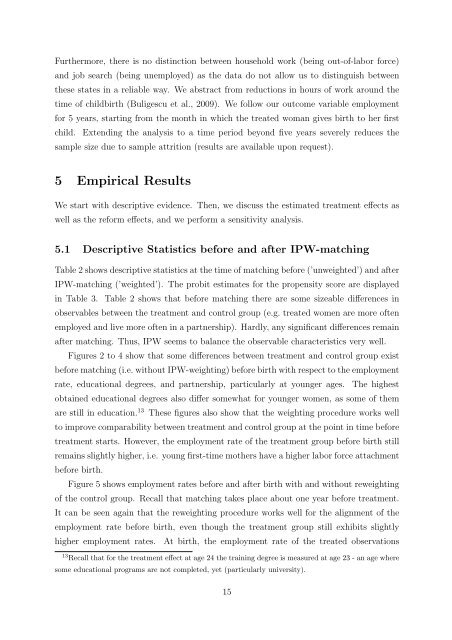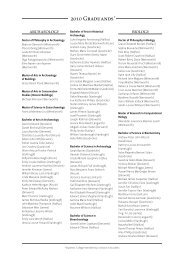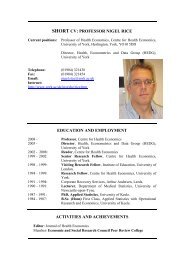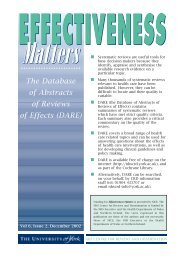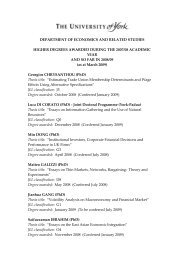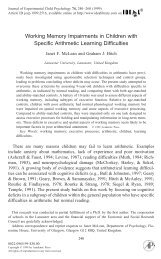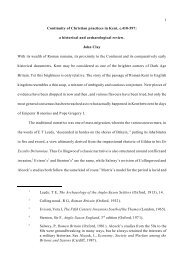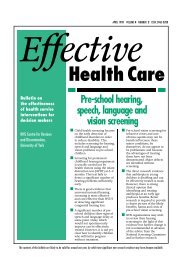Causal effects on employment after first birth - A ... - University of York
Causal effects on employment after first birth - A ... - University of York
Causal effects on employment after first birth - A ... - University of York
Create successful ePaper yourself
Turn your PDF publications into a flip-book with our unique Google optimized e-Paper software.
Furthermore, there is no distincti<strong>on</strong> between household work (being out-<strong>of</strong>-labor force)and job search (being unemployed) as the data do not allow us to distinguish betweenthese states in a reliable way. We abstract from reducti<strong>on</strong>s in hours <strong>of</strong> work around thetime <strong>of</strong> child<strong>birth</strong> (Buligescu et al., 2009). We follow our outcome variable <strong>employment</strong>for 5 years, starting from the m<strong>on</strong>th in which the treated woman gives <strong>birth</strong> to her <strong>first</strong>child. Extending the analysis to a time period bey<strong>on</strong>d five years severely reduces thesample size due to sample attriti<strong>on</strong> (results are available up<strong>on</strong> request).5 Empirical ResultsWe start with descriptive evidence. Then, we discuss the estimated treatment <str<strong>on</strong>g>effects</str<strong>on</strong>g> aswell as the reform <str<strong>on</strong>g>effects</str<strong>on</strong>g>, and we perform a sensitivity analysis.5.1 Descriptive Statistics before and <strong>after</strong> IPW-matchingTable 2 shows descriptive statistics at the time <strong>of</strong> matching before (’unweighted’) and <strong>after</strong>IPW-matching (’weighted’). The probit estimates for the propensity score are displayedin Table 3. Table 2 shows that before matching there are some sizeable differences inobservables between the treatment and c<strong>on</strong>trol group (e.g. treated women are more <strong>of</strong>tenemployed and live more <strong>of</strong>ten in a partnership). Hardly, any significant differences remain<strong>after</strong> matching. Thus, IPW seems to balance the observable characteristics very well.Figures 2 to 4 show that some differences between treatment and c<strong>on</strong>trol group existbefore matching (i.e. without IPW-weighting) before <strong>birth</strong> with respect to the <strong>employment</strong>rate, educati<strong>on</strong>al degrees, and partnership, particularly at younger ages. The highestobtained educati<strong>on</strong>al degrees also differ somewhat for younger women, as some <strong>of</strong> themare still in educati<strong>on</strong>. 13 These figures also show that the weighting procedure works wellto improve comparability between treatment and c<strong>on</strong>trol group at the point in time beforetreatment starts. However, the <strong>employment</strong> rate <strong>of</strong> the treatment group before <strong>birth</strong> stillremains slightly higher, i.e. young <strong>first</strong>-time mothers have a higher labor force attachmentbefore <strong>birth</strong>.Figure 5 shows <strong>employment</strong> rates before and <strong>after</strong> <strong>birth</strong> with and without reweighting<strong>of</strong> the c<strong>on</strong>trol group. Recall that matching takes place about <strong>on</strong>e year before treatment.It can be seen again that the reweighting procedure works well for the alignment <strong>of</strong> the<strong>employment</strong> rate before <strong>birth</strong>, even though the treatment group still exhibits slightlyhigher <strong>employment</strong> rates. At <strong>birth</strong>, the <strong>employment</strong> rate <strong>of</strong> the treated observati<strong>on</strong>s13 Recall that for the treatment effect at age 24 the training degree is measured at age 23 - an age wheresome educati<strong>on</strong>al programs are not completed, yet (particularly university).15


